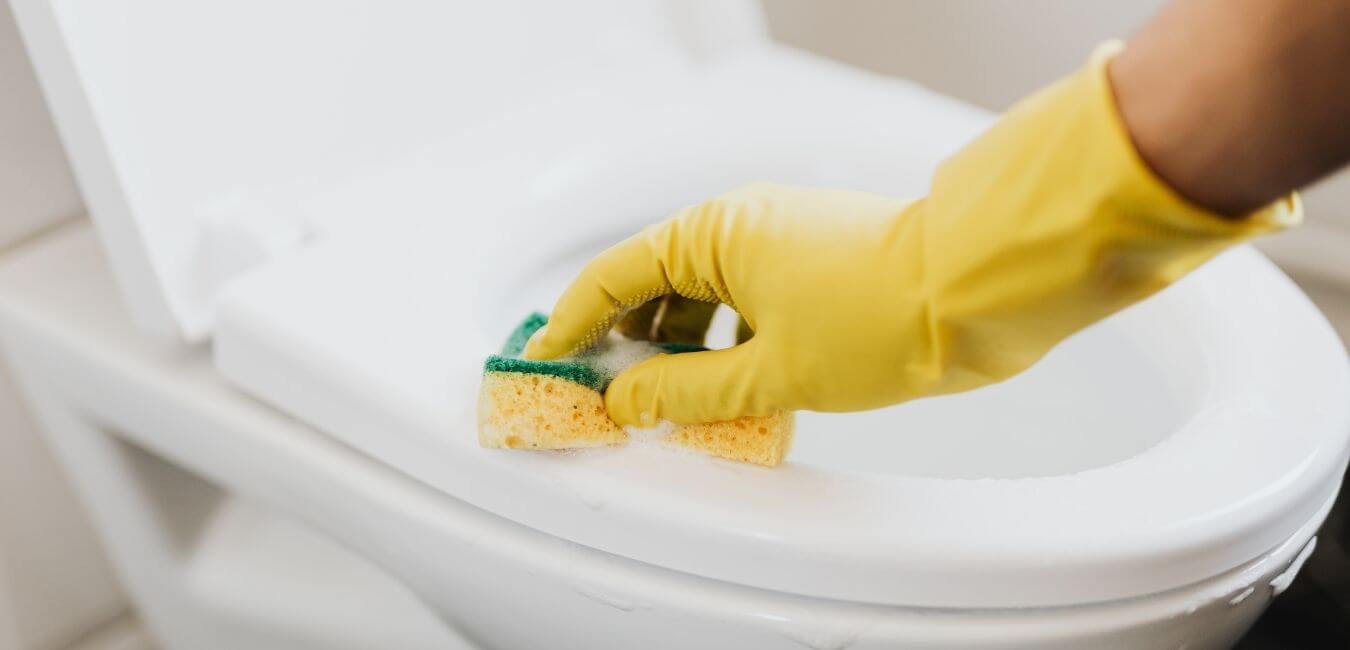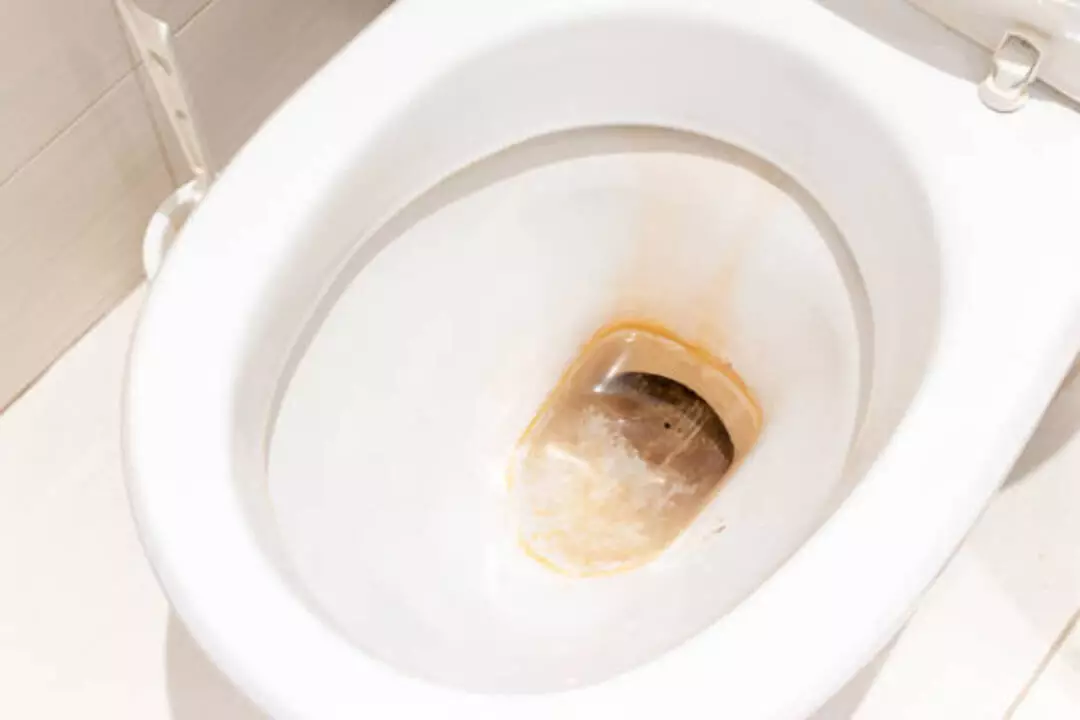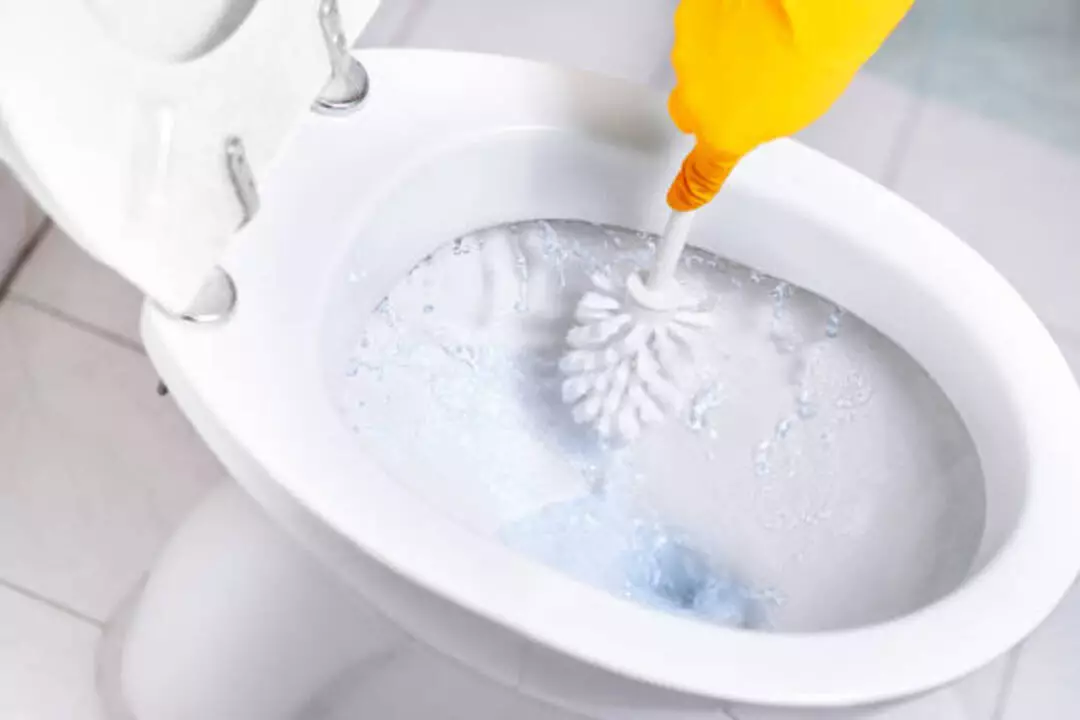Does your toilet bowl sport an unsightly blue stain that stubbornly resists all cleaning? These stains are often the result of chemical reactions from certain cleaning products or even the copper pipes in your home.
This comprehensive guide is designed to help you effectively remove blue stains from your toilet bowl, delving into their common causes, important factors for safe and efficient removal, tried-and-true removal techniques, and preventive measures to keep them at bay.
Read on to find out how to restore your toilet bowl’s sparkling cleanliness with ease!
KEY INFORMATION
- Blue stains in your toilet bowl can be caused by chemical reactions from cleaning products, copper pipes or fixtures, and the presence of bacteria or algae.
- When removing blue stains, consider factors such as the type of stain (chemical or mineral), safety precautions like wearing protective gear, and choosing the right cleaning product.
- Effective methods for removing blue stains include using denture tablets, oxygen bleach, isopropyl alcohol, or chlorine bleach. Follow the instructions carefully and use proper safety precautions when using these methods.
- Preventive measures to avoid blue stains include regularly cleaning and maintaining your toilet bowl, avoiding harsh cleaning products that can cause reactions, and checking or replacing old plumbing fixtures like copper pipes.
Causes of Blue Stains in the Toilet Bowl

Chemical reactions from cleaning products, copper pipes or fixtures, and the presence of bacteria or algae can all cause blue stains in your toilet bowl.
1. Chemical reactions from cleaning products
Cleaning products can cause blue stains in your toilet bowl. Some cleaners have blue dyes. Your toilet bowl may turn blue when you use it. Another reason is a mix of two or more cleaners with different chemicals.
This can react and leave a stain, too. So, watch out what you clean with! And if possible, avoid using harsh products that might cause these chemical reactions. Try safer options like baking soda and vinegar instead.
These are also good for the environment!
2. Copper pipes or fixtures
Copper pipes or fixtures in your toilet can also be a cause of blue stains. When copper comes into contact with certain chemicals present in water, it can result in a reaction that leads to the formation of blue-green stains.
This is known as copper corrosion. If you notice blue stains in your toilet bowl and have copper plumbing, it’s important to consider this as a possible cause. To prevent these stains from occurring, you may need to check and replace any old or corroded copper pipes or fixtures in your toilet system.
Regular maintenance and inspection of your plumbing can help identify and address any issues before they cause staining in your toilet bowl.
3. Presence of bacteria or algae
Bacteria and algae can also be responsible for the presence of blue stains in your toilet bowl. These microorganisms thrive in damp environments and can easily grow on surfaces like porcelain.
When they multiply, they can create a slimy film that appears blue or green in color. This slime can adhere to the surface of the toilet bowl, causing unsightly stains. To effectively remove these stains, it’s important to use cleaning products that specifically target bacteria and algae.
Regularly cleaning your toilet bowl will help prevent their growth and keep your bathroom clean and fresh.
Factors to Consider When Removing Blue Stains

When removing blue stains from your toilet bowl, there are several factors you should consider. These include the type of stain (chemical or mineral), safety precautions such as using protective gear, and the type of cleaning product that is most effective for tackling the specific stain.
1. Type of stain (chemical or mineral)
There are two types of stains that can appear in your toilet bowl: chemical stains and mineral stains. Chemical stains are caused by reactions from cleaning products or dyes, such as blue dye.
Mineral stains, on the other hand, result from minerals like iron or copper in the water supply. It’s important to identify the type of stain you have before choosing a cleaning method.
For chemical stains, using baking soda and vinegar can be effective, while mineral stains may require a cleaner specifically designed for removing mineral deposits.
2. Safety precautions (protective gear)
To ensure your safety when removing blue stains from your toilet bowl, it is important to take some safety precautions and wear protective gear. This includes wearing rubber gloves to protect your hands from any chemicals or bacteria that may be present in the stains.
Additionally, it is recommended to wear safety goggles to protect your eyes from splashes or fumes while cleaning. Remember to read and follow the instructions on the cleaning products you use, as they may have specific safety guidelines for handling and application.
By taking these safety precautions, you can effectively remove blue stains without putting yourself at risk of any harm.
3. Types of cleaning product to use
To effectively remove blue stains from your toilet bowl, it’s important to choose the right cleaning product. One option is to use a mixture of baking soda and vinegar. These household items are recommended by the EPA for their cleaning properties.
Another choice is oxygen bleach, which can help break down and remove stubborn stains. Isopropyl alcohol is also effective in removing blue stains, as it helps dissolve the chemicals causing the discoloration.
Additionally, chlorine bleach can be used as a last resort if other methods are not successful, but it should be used with caution due to its strong chemical composition. Remember to always follow safety precautions and read product labels before using any cleaning products on your toilet bowl.
Methods of Removing Blue Stains
There are several effective methods you can try to remove those stubborn blue stains from your toilet bowl, including using denture tablets, oxygen bleach, isopropyl alcohol, and chlorine bleach.
Find out which method works best for you and say goodbye to those unsightly stains!
1. Using denture tablets
To remove blue stains from your toilet bowl, you can try using denture tablets. Here’s how:
- Drop a denture tablet into the toilet bowl.
- Let it fizz and dissolve for about 30 minutes.
- Use a toilet brush to scrub the stains gently.
- Flush the toilet to rinse away the residue.
2. Using oxygen bleach
Oxygen bleach is a great option for removing blue stains from your toilet bowl. Here’s how you can use it effectively:
- Start by flushing the toilet to wet the bowl.
- Sprinkle oxygen bleach powder directly onto the stained areas of the bowl.
- Use a toilet brush to scrub the powder into the stains.
- Let the oxygen bleach sit in the bowl for about 15 – 20 minutes.
- Scrub the stained areas again with the toilet brush.
- Flush the toilet to rinse away the bleach and reveal a clean, stain-free bowl.
3. Using isopropyl alcohol
To effectively remove blue stains from your toilet bowl, you can use isopropyl alcohol. Here’s how:
- Dampen a clean cloth or sponge with isopropyl alcohol.
- Gently scrub the stained areas of the toilet bowl using a cloth or sponge.
- Let the alcohol sit on the stains for a few minutes to break them down.
- Use a toilet brush to scrub the stains further, if needed.
- Flush the toilet to rinse away any residue.
4. Using chlorine bleach
To remove blue stains from your toilet bowl, you can use chlorine bleach. Here’s how:
- Put on protective gloves and open a window for ventilation.
- Pour half a cup of chlorine bleach into the toilet bowl.
- Let the bleach sit for about 15 minutes to break down the stains.
- Scrub the toilet bowl with a toilet brush to remove the stains.
- Flush the toilet to rinse away the bleach and any remaining stains.
Preventive Measures to Avoid Blue Stains

To avoid blue stains in your toilet bowl, regularly clean and maintain the bowl to prevent buildup. Avoid using harsh cleaning products that can cause chemical reactions. Additionally, check and replace old plumbing fixtures, such as copper pipes or fixtures, which may contribute to blue staining.
1. Regular cleaning and maintenance
Regular cleaning and maintenance are essential to prevent blue stains in your toilet bowl. By regularly cleaning the bowl, you can remove any buildup or residue that may contribute to the staining.
Use a toilet bowl cleaner that is specifically designed for stain removal or make your own by mixing baking soda and vinegar together. Scrub the bowl thoroughly with a toilet brush to ensure all areas are cleaned.
In addition to regular cleaning, it’s important to check and replace old plumbing fixtures, such as copper pipes or fixtures, which can lead to chemical reactions causing blue stains.
Avoid using harsh cleaning products that contain blue dyes, as they can contribute to staining. Instead, opt for natural cleaning solutions like vinegar or hydrogen peroxide.
Taking these preventive measures will help keep your toilet bowl clean and free from blue stains. Remember to always follow safety precautions when handling cleaning products and wear protective gear if necessary.
2. Avoiding harsh cleaning products
To prevent blue stains in your toilet bowl, it’s important to avoid using harsh cleaning products. These products can contain chemicals that react with the minerals in the water and cause stains.
Instead, opt for gentler alternatives like baking soda and vinegar, which are effective at removing stains without causing any damage. You can also consider using natural cleaning solutions or environmentally friendly cleaners that are specifically designed for toilets.
By avoiding harsh cleaning products, you can keep your toilet bowl clean and stain-free while also protecting the environment.
3. Checking and replacing old plumbing fixtures
To prevent blue stains in your toilet bowl, it’s important to regularly check and replace any old plumbing fixtures. Over time, old fixtures can deteriorate or develop leaks, which can cause water with chemicals or minerals to seep into the toilet bowl and create stains.
By inspecting your plumbing fixtures periodically, you can identify any signs of wear and tear or leaks that may be contributing to the problem. If you notice any issues, such as corroded pipes or worn-out valves, it’s best to replace them promptly to maintain the integrity of your plumbing system and prevent further staining in the future.
Remember, a well-maintained plumbing system is crucial for keeping your toilet bowl clean and free from blue stains.
Frequently Asked Questions

1. What are the causes of blue stains in my toilet bowl?
Blue stains can form from blue dye used in some cleaning supplies or minerals present in your water.
2. What methods can I use to remove the blue stains from my toilet bowl?
You can use a pumice stone or specific household cleaning products that help with toilet bowl stain removal, like those aimed at removing blue dye stains.
3. How do I know which method is best for removing my toilet’s blue stains?
There are many factors to consider when choosing stain removal techniques like the cause of the stain and the type of toilet seat material.
4. Are there preventive measures I can take to avoid these blue stains on my toilet bowl?
Yes, by following regular effective ways of maintaining cleanliness and using safe cleaning supplies prevents recurring build-up of these stubborn stains.
5. Where can I find a guide that will help me effectively remove these troublesome blue spots?
A comprehensive guide detailing various methods to eliminate such stubborn marks including step-by-step procedures and preventive measures should assist you through this process. Stain Removal guides such as “Effective Ways To Remove Blue Stains From Your Toilet Bowl: A Comprehensive Guide..” offer valuable insights into handling this issue.
Conclusion and final thoughts
In conclusion, removing blue stains from your toilet bowl can be done effectively by considering the causes of the stain and using the right methods. Factors like the type of stain and safety precautions should also be taken into account.
Methods such as using denture tablets, oxygen bleach, or isopropyl alcohol can help remove the stains. To prevent future staining, regular cleaning and maintenance are important, along with avoiding harsh cleaning products and checking plumbing fixtures.
With these tips in mind, you can keep your toilet bowl free from blue stains and maintain a clean bathroom environment.















